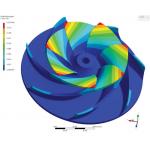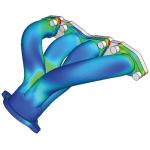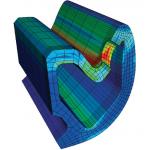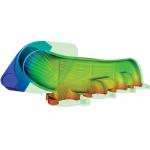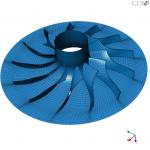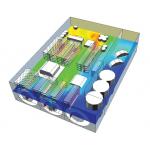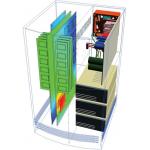June 1, 2005
By Louise Elliott
Structural analysis studies the behavior of solid structures under a number of different loading conditions, focusing on stress, contact, plasticity, large, and small deformations—basically upon the behavior of the structure itself. CFD (computational fluid dynamics) studies the behavior and effects of fluids moving around and through structures. The two disciplines meet at the surfaces of the solid structure, and each may provide loads and boundaries for the other.
|
|
| An ANSYS Workbench simulation of a centrifugal pump deformation. Click on image to enlarge. |
A few years ago, ANSYS purchased CFX, one of the “Big Three” high-end CFD codes, and has now integrated it, to a large degree, with the company’s multiphysics solvers within the Workbench interface. The other members of the Big Three, Fluent and CD-adapco Group, are working with a number of developers of complex FEA (finite element analysis) programs to provide coupled fluid-structural interaction (FSI) capabilities.
Most of the action takes place at the high end because of the extreme nonlinearity of CFD (its need to work with nonlinear structural codes) as recalculation takes place at each time step (or even within time steps), and because the kinds of problems that are likely to require FSI analysis are very complex and usually involve nonlinear structural behavior.
Earlier in 2005, Fluent and ABAQUS announced the availability of a coupled solution. Fluent is also working with MSC.Software and UGS’s NX Nastran, and its integration with ADINA nonlinear analysis. CD-adapco is also planning coupled solutions for the same FEA codes.
|
|
| Coupled simulation of heat transfer between the hot exhaust stream and the car’s manifold is critical to understanding its thermal stress history. Image courtesy of Fluent Inc. and ABAQUS. |
“We focus on advanced FEA, and offer a general-purpose program that’s structurally focused,” explains Dale Berry, manager of engineering applications for ABAQUS. “Our users, however, often need to couple fluid flows with their ABAQUS analyses—in applications such as the durability of a race car wing. They need to know how the fluid presses around and against the structure, along with the distribution of pressure, to determine its likely life or whether it will tear off the vehicle.”
MpCCI—the enabler
The partnership between ABAQUS and Fluent includes a third partner—Fraunhofer SCAI, a nonprofit German developer of software called MpCCI—providing the intercommunication backbone for the coupled capabilities.
“This type of integration is easy to extend because it will work with any code that’s MpCCI-enabled,” says Barb Hutchings, director of strategic partnerships for Fluent.
|
|
| This simulation of the stress in a car door seal was performed in Fluent and ABAQUS, plotted using EnSight Gold by CEI. |
However, Berry points out that the three-way partnership does raise deployment issues. “It means users have to pay for and license a third program, but it does make it easier to communicate between the two kinds of code, and provides benefits that make it worth the cost and trouble.”
Those benefits largely mean that two different groups of engineers, one well versed in ABAQUS and the other expert at using Fluent, can link up collaboratively. “Where the two sets of analyses meet, MpCCI lets users see the mutual surface of the two domains,” Berry says. “That’s all analysts care about when coupling these tools. They care about what happens at the boundaries. Structures feel fluid pressures and heat flux at the common boundary. The fluid side sees temperature effects and displacement—and asks where the surface is right now, if it’s moving.”
|
|
| These pathlines predict the flow of exhaust in a cold start during the same simulation seen on page 19. The simulation uses a coupling between FLUENT 6.2 and ABAQUS 6.5, displayed in EnSight Gold from CEI. |
Hutchings points out a famous example of fluids impacting structures, and moving structures impacting fluids: “The Tacoma Narrows Bridge was an old bridge that tore apart under particular wind loading that made the bridge oscillate,” Hutchings says. “That movement caused enhanced fluids loading until the bridge shook itself apart. The effects of coupled loadings can be positive or negative; and one way or another can affect design decisions.”
More Than One Approach to Coupling
“Many simulation problems need fluid and structural interaction, and when problems are sufficiently nonlinear to require passing of information back and forth at each time step, customers ask for this interaction,” says Dennis Nagy, vice president of business development for CD-adapco Group. He adds that although MpCCI does offer an approach, it may be difficult to use because the manufacturer has no sales organization in North America. “This doesn’t please the military for instance, who often want coupled capabilities.”
CD-adapco has used MpCCI, but Nagy cautions that it’s not a push-button solution. “Users have to decide what data needs to go back and forth between the codes. The application should be a two-way flow of information, especially where the structural boundaries may change—co-simulation, with both codes running at the same time, doing transient time—and history-dependent simulation. It requires engineers to make it work.”
Nagy says that CD-adapco will work at coupling its STAR-CD with such structural codes as MSC.Marc, NX, and ADINA, and might decide to integrate directly with ABAQUS to get greater granularity (that is, share information between time steps) than is possible with MpCCI.
ANSYS Goes It Alone
“The Workbench infrastructure supports coupling of ANSYS and CFX,” agrees Mike Wheeler, vice president and general manager of the ANSYS mechanical business unit and Chris Reid, who holds the same title in the fluids business unit. Specifically, they say that high-speed communications tools inside the interface make it unnecessary to use third-party communication tools.
|
|
| This compressor fan geometry was designed using ANSYS BladeModeler and it was meshed for simulation using ANSYS TurboGrid. |
“Inside this interface,” says Wheeler, “we don’t have two separate applications that need different pre- and postprocessing, multiple models, and different meshes. CFX and ANSYS work with a single geometric representation inside Workbench, with which users can take arbitrary fluid and structural meshes and run both.”
Reid points out that if a user wants to solve fluids, he needs a mesh that looks for transitions along the boundaries as well as stress concentrations. “With fluids, the problem requires creating a geometric representation and meshing the whole fluid field around an object.”
In practical application, ANSYS FSI intends to offer an end-to-end solution for turbo machinery. “Aerodynamics design engineers can start with geometry for blades,” Reid says, “using an ANSYS product called BladeModeler, and pass the geometry to a turbo grid for a CFD mesh that includes technology from both CFX and ICEM.” The tools have connectivity in Workbench, where users can perform CFD-intensive design analysis and also perform structural validation and see the effects of fluid flows on the blades.
The other CFD developers have encountered situations where customers already use ANSYS for structural analysis, and use either Fluent or STAR-CD for CFD. Thus far, according to Dennis Nagy, ANSYS has not been helpful in working with CFD codes other than CFX. However, ANSYS says that Workbench includes published APIs and software development kits to enable third parties to work with ANSYS.
Open UGS Architecture to Benefit Indy Developers
NX has its own thermal/fluid module, which existed in I-deas before UGS and SDRC merged. Don Tolle, product manager for digital simulation for UGS says that the company has, for a long time, worked in partnership with Maya Heat Transfer Technologies, a Montreal-based fluid and heat transfer analysis developer, to provide electronic system cooling applications.
|
|
| This image illustrates a combined thermal/flow cooling simulation of a power supply using UGS NX (I-deas NX Series). |
“When NX version 4 is released in the fall, that capability will be integrated in it,” Tolle says, “along with other capabilities resulting from our integration of ADINA’s advanced nonlinear capabilities as an add-on NX Nastran module. But we have an open philosophy, so independent CFD developers can work with NX through our APIs.”
UGS is currently discussing ways to couple CFD and structural analysis with CD-adapco and Fluent. However, says Tolle, “We aren’t going the MpCCI route at the moment, although we’re investigating it. We make it possible for our users to work with the structural solvers of their choice, and that includes ANSYS, of course, as well as ABAQUS and MSC.Nastran and Marc.”
|
|
| This is a fully coupled thermal/flow simulation of a computer electronics system in UGS NX (I-deas NX Series). |
Future FSI
At ABAQUS, Berry says that some code developers have studied the possibility of developing FSI in a tightly coupled approach, but says that so far this has not been successful, mostly “because it would change the way both programs work, and users would need to learn new tools.”
But Fluent’s Hutchings thinks that resistance to new tools might fade in view of recent changes in the use of analysis overall. “Years ago, these were individual analysis disciplines,” she says, “but now we’re trying to impact up-front design, and that presents organizational challenges of its own.”
ANSYS’s Reid says that capabilities coupled in multiphysics analyses can solve more complex problems, and offer better answers. “We’ve come a long way toward creating FSI, which offers significant advantages to the user who doesn’t have to cobble together solutions.”
Nagy points out that CD-adapco is currently working with MpCCI and directly with structural analysis vendors. “Direct coupling takes more time, and needs developers assigned to program it,” he says, but also notes that whether used together or side by side, structural and fluids codes help users solve problems that could not have been done before. “We recently saw a presentation of the use of STAR-CD on an ABAQUS model of a natural human tissue heart valve, which is terribly difficult to simulate.”
Contributing Editor Louise Elliott is a freelance writer based in California. Offer Louise your feedback on this article through DE‘s Editors.
Company Information
ABAQUS, Inc.
Providence, RI
ANSYS, Inc.
Canonsburg, PA
CD-adapco
London, England
Computational Engineering Intl. —CEI
Apex, NC
Fluent, Inc.
Lebanon, NH
Fraunhofer SCAI
Sankt Augustin, Germany
ICEM Ltd.
Southampron, England
UGS
Plano, TX
Subscribe to our FREE magazine, FREE email newsletters or both!
About the Author
DE’s editors contribute news and new product announcements to Digital Engineering.
Press releases may be sent to them via [email protected].







